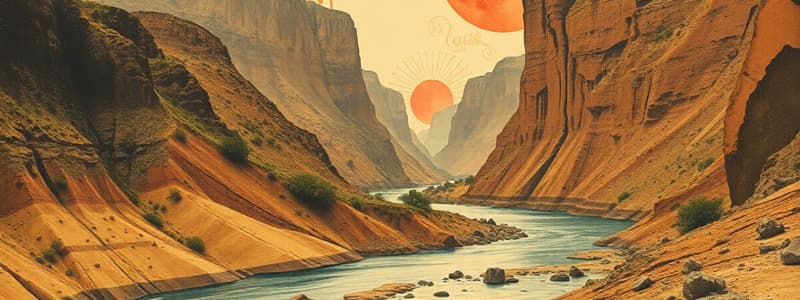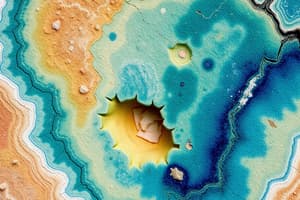Podcast
Questions and Answers
What causes the vertical movement of the Earth's crust known as isostasy?
What causes the vertical movement of the Earth's crust known as isostasy?
- The effects of erosion on the landscape
- The movement of tectonic plates
- The addition and removal of weight from the crust (correct)
- The melting of ice caps around the globe
Which of the following features is NOT a result of isostatic changes?
Which of the following features is NOT a result of isostatic changes?
- Knickpoints
- Incised meanders
- Glacial valleys (correct)
- Paired terraces
What process describes the formation of multiple knickpoints due to rejuvenation over time?
What process describes the formation of multiple knickpoints due to rejuvenation over time?
- Lateral erosion
- Headward erosion (correct)
- Tectonic uplift
- Vertical erosion
In which landscape feature do rivers erode downwards while retaining their meanders to form a steep valley?
In which landscape feature do rivers erode downwards while retaining their meanders to form a steep valley?
What happens to the floodplain when paired terraces are formed?
What happens to the floodplain when paired terraces are formed?
Flashcards
Isostasy
Isostasy
The vertical movement of the Earth's crust due to changes in weight, leading to compression or rebound.
Knickpoint
Knickpoint
A point in a river where there is a change in gradient, often marked by rapids or a waterfall.
Incised Meanders
Incised Meanders
Meanders that have steep, symmetrical valleys formed by a river's increased downward erosion.
Paired Terraces
Paired Terraces
Signup and view all the flashcards
Rejuvenation
Rejuvenation
Signup and view all the flashcards
Study Notes
Isostasy and Fluvial Landscapes
- Isostasy is the vertical movement of Earth's crust. Added weight compresses the crust; removed weight causes rebound. This is called isostatic change.
Isostasy in Ireland
- Isostasy in Ireland is largely due to glaciers from the last ice age.
- Glacial weight compressed the crust.
- Melting ice removed the weight, causing crust rebound.
- This rejuvenation of rivers created features like knickpoints, incised meanders, and paired terraces.
Knickpoints
- A knickpoint is a change in the river's gradient, often marked by rapids or waterfalls.
- It's where a rejuvenated river profile meets an older one.
- Multiple rejuvenation periods can create multiple knickpoints.
- Knickpoints are eventually removed by headward erosion.
Incised Meanders
- Isostasy increases a river's erosive power, leading to vertical erosion dominating lateral erosion.
- River erodes downwards, but meanders remain, forming a steep, symmetrical valley with the meanders at a lower level than the surrounding floodplain.
Paired Terraces
- Rivers vertically erode, forming a new floodplain below its previous level (an old terrace).
- This process repeats creating numerous terraces at different levels surrounding the river floodplain.
Example of Isostasy Impact
- The Barrow River shows evidence of these isostatic impacts.
Studying That Suits You
Use AI to generate personalized quizzes and flashcards to suit your learning preferences.




